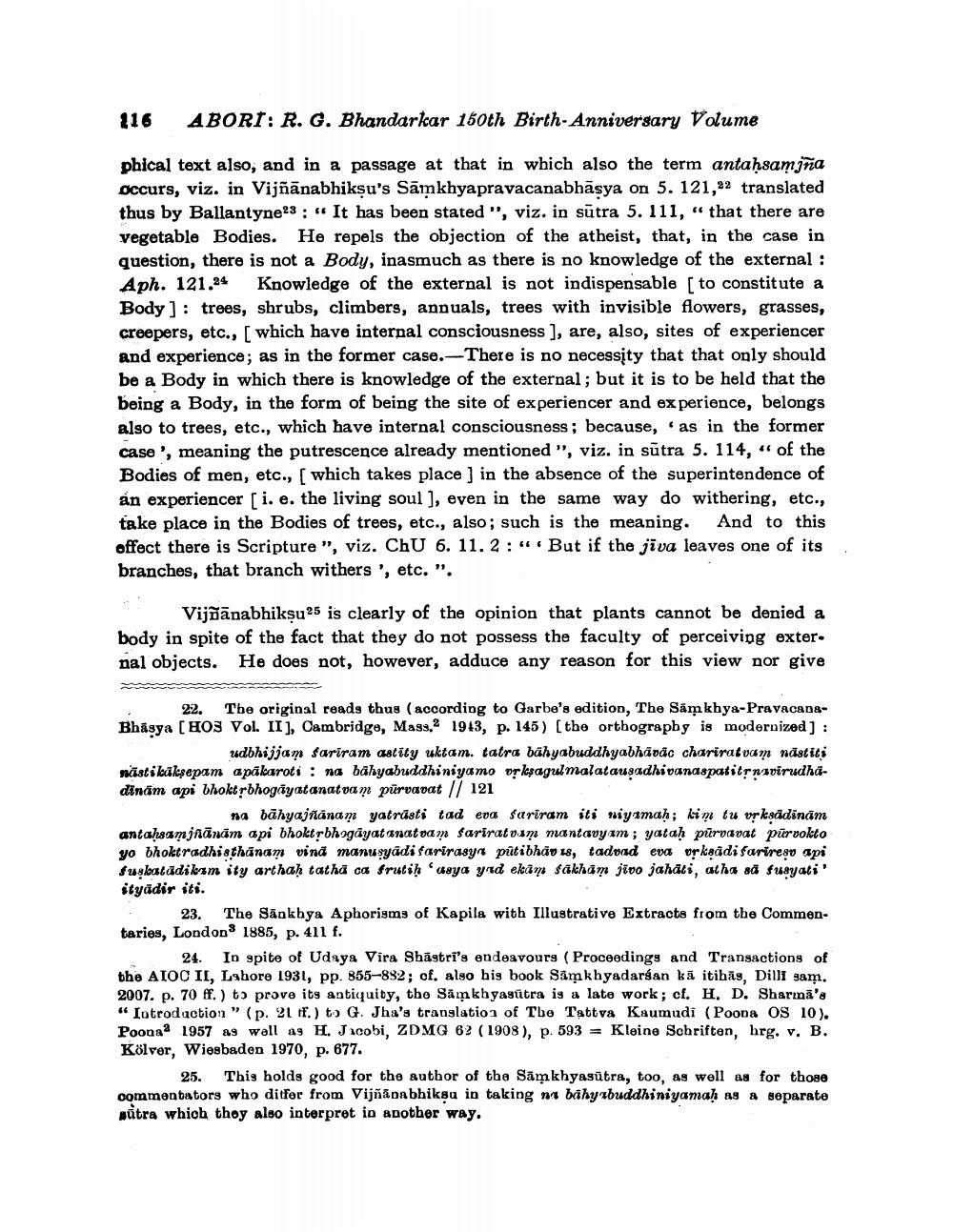Book Title: On Term Antahsamjna Author(s): A Wezler Publisher: A Wezler View full book textPage 6
________________ 116 ABORI: R. G. Bhandarkar 150th Birth-Anniversary Volume phical text also, and in a passage at that in which also the term antaḥsamiña occurs, viz. in Vijñānabhiksu's Samkhyapravacanabhäsya on 5. 121,92 translated thus by Ballantyne23 : “ It has been stated ", viz. in sūtra 5. 111, “ that there are vegetable Bodies. He repels the objection of the atheist, that, in the case in question, there is not a Body, inasmuch as there is no knowledge of the external : Aph. 121.24 Knowledge of the external is not indispensable ( to constitute a Body ) : trees, shrubs, climbers, annuals, trees with invisible flowers, grasses, creepers, etc., [ which have internal consciousness ), are, also, sites of experiencer and experience; as in the former case. There is no necessity that that only should be a Body in which there is knowledge of the external; but it is to be held that the being a Body, in the form of being the site of experiencer and experience, belongs also to trees, etc., which have internal consciousness; because, as in the former case ', meaning the putrescence already mentioned ", viz. in sūtra 5. 114," of the Bodies of men, etc., ( which takes place ) in the absence of the superintendence of an experiencer [i. e. the living soul ), even in the same way do withering, etc., take place in the Bodies of trees, etc., also; such is the meaning. And to this offect there is Scripture", viz. ChU 6. 11.2: " But if the jīva leaves one of its branches, that branch withers ', etc.". Vijñānabhiksu 25 is clearly of the opinion that plants cannot be denied a body in spite of the fact that they do not possess the faculty of perceiving exter. nal objects. He does not, however, adduce any reason for this view nor give 22. The original reads thus (according to Garbe's edition, The Samkhya-PravacangBhāgya [H03 Vol. II ], Cambridge, Mass. 1943, p. 145) [the orthography is modernized ) : udbhijjam sariram astity uktam. tatra bāhyabuddhyabhāvac chariratuam năstiti nästikāksepam apakaroti : na bähyabuddhiniyamo osksagulmalatausadhivanaspatitrnsvirudhadinām aps bhoktrbhogayatanatvan pūrvavat // 121 na bāhyajñānam yatrūsti tad era sariram iti niyamah; kim tu vyksādinām antahsam jānām api bhoktrbhogayat anatoam sariratuim mantavy am ; yatah pūrvavat pūrvokto yo bhoktradhisthānam vina manusyadi farirasyn pūtibhau 18, tadvad eva orkaadi Fariresu api fuglatadikam ity arthah tatha ca frutih asya yad ekan sakham jāno jahati, atha să fu8yati' ityādir sti. 23. The Sankhya Aphorisms of Kapila with Illustrative Extracts from the Commentaries, London 1885, p. 411 f. 24. In gpite of Udays Vira Shāstri's endeavours (Proceedings and Transactions of the AIOO II, Lahore 1931, pp. 855-892; cf. also his book Simkhyadarsan kā itibās, Dilli sam. 2007. p. 70 ff.) to prove its antiquity, the Sănkhyasūtra is a late work; cf. H. D. Sharina's “ Iotroduction" (p. 21 tf.) to G. Jha's translation of Tbe Tattva Kaumudi (Poona OS 10). Poonaa 1957 as well as H. Jacobi, ZDMG 62 (1908), p. 593 = Kleine Schriften, hrg. v. B. Kölver, Wiesbaden 1970, p. 677. 25. This holds good for the author of the Samkhyasūtra, too, as well as for those commentators who ditfer from Vijñāpabhiksu in taking n bahy buddhiniyamah ag a separate putra which thoy also interpret in another way.Page Navigation
1 ... 4 5 6 7 8 9 10 11 12 13 14 15 16 17 18 19 20 21
